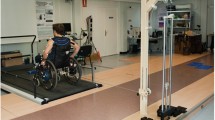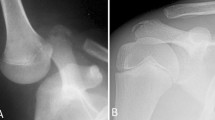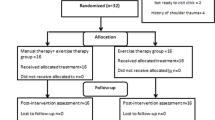Abstract
This study compared peak torque and torque steadiness during isometric abduction in subjects with subacromial impingement syndrome (SIS) and those with no upper limb disorders. The SIS group consisted of 27 subjects (33.48 ± 9.94 years) with unilateral SIS. The control group consisted of 23 healthy and active subjects (32.26 ± 9.04 years). Peak torque and torque steadiness were measured during isometric abduction (80º in the scapular plane) of the shoulder. Standard deviation, coefficient of variation, stability time, median frequency, and relative power were measured from the steadiness trials. There were neither significant interactions between group and side (P > 0.05), nor were there significant main effects of group and side (P > 0.05) for all variables analyzed. The results of this study showed that steadiness is preserved by SIS during isometric abduction of the shoulder.


Similar content being viewed by others
References
Ardic F, Kahraman Y, Kacar M et al (2006) Shoulder impingement syndrome—relationships between clinical, functional, and radiologic findings. Am J Phys Med Rehabil 85:53–60. doi:10.1097/01.phm.0000179518.85484.53
Bandholm T, Rasmussen L, Aagaard P et al (2006) Force steadiness, muscle activity and maximal muscle strength in subjects with subacromial impingement syndrome. Muscle Nerve 34:631–639. doi:10.1002/mus.20636
Bandholm T, Rasmussen L, Aagaard P et al (2008) Effects of experimental muscle pain on shoulder-abduction force steadiness and muscle activity in healthy subjects. Eur J Appl Physiol 102:643–650. doi:10.1007/s00421-007-0642-1
Baratta RV, Solomonow M, Zhou B-H (1998) Frequency domain-based models of skeletal muscle. J Electromyogr Kinesiol 8:79–91. doi:10.1016/S1050-6411(97)00024-2
Booth FW, Lees SJ (2006) Physically active subjects should be the control group. Med Sci Sports Exerc 38:405–406. doi:10.1249/01.mss.0000205117.11882.65
Camargo PR, Haik MN, Filho RB et al (2007) Pain in workers with shoulder impingement syndrome: an assessment using the DASH and McGill pain questionnaires. Rev Bras Fisioter 11:161–167. doi:10.1590/S1413-35552007000200012
Camargo PR, Haik MN, Filho RB et al (2008) Bilateral deficits in muscle contraction parameters during shoulder scaption in patients with unilateral subacromial impingement syndrome. Isokinet Exerc Sci 16:93–99
Camargo PR, Haik MN, Ludewig PM et al (2009) Effects of strengthening and stretching exercises applied during working hours on pain and physical impairment in workers with subacromial impingement syndrome. Physiother Theory Pract (in press)
Christou EA (2005) Visual feedback attenuates force fluctuations induced by stressor. Med Sci Sports Exerc 37:2126–2133. doi:10.1249/01.mss.0000178103.72988.cd
Ellenbecker TS, Davies GJ (2000) The application of isokinetics in testing and rehabilitation of the shoulder comples. J Athl Train 35:338–350
Enoka RM, Christou EA, Hunter SK et al (2003) Mechanisms that contribute to differences in motor performance between young and old adults. J Electromyogr Kinesiol 13:1–12. doi:10.1016/S1050-6411(02)00084-6
Gołebiewska JA, Mastalerz A, Zieliński JR (2008) Isokinetic muscle torque during glenohumeral rotation in dominant and nondominant limbs. Acta Bioeng Biomech 10:69–73
Graves AE, Kornats KW, Enoka RM (2000) Older adults use a unique strategy to lift inertial loads with the elbow flexor muscles. J Neurophysiol 83:2030–2039
Hudak PL, Amadio PC, Bombardier C (1996) Development of an upper extremity outcome measure: the DASH. Am J Ind Med 29:602–606. doi:10.1002/(SICI)1097-0274(199606)29:6<602::AID-AJIM4>3.0.CO;2-L
James CR (2004) Considerations of movement variability in biomechanics. In: Stergiou N (ed) Innovative analyses of human movement. Human Kinetics, Champaign, pp 29–62
Lavender AP, Nosaka K (2007) Fluctuations of isometric force after eccentric exercise of the elbow flexors of young, middle-aged, and old men. Eur J Appl Physiol 100:161–167. doi:10.1007/s00421-007-0418-7
Machner A, Merk H, Becker R et al (2003) Kinesthetic sense of the shoulder in patients with impingement syndrome. Acta Orthop Scand 74:85–88. doi:10.1080/00016470310013716
Mattiello-Rosa SM, Camargo PR, Santos AAS et al (2008) Abnormal isokinetic time-to-peak torque of the medial rotators of the shoulder in subjects with impingement syndrome. J Shoulder Elbow Surg 17:54S–60S. doi:10.1016/j.jse.2007.08.006
Phadke V, Camargo PR, Ludewig PM (2009) Scapular and rotator cuff muscle activity during arm elevation: a review of normal function and alterations with shoulder impingement. Rev Bras Fisiot 13:1–9
Sapega AA (1990) Muscle performance evaluation in orthopaedic practice: current concepts review. J Bone Joint Surg 72A:1562–1574
Schouten AC, Mugge W, van der Helm FCT (2008) NMClab, a model to assess the contributions of muscle visco-elasticity and afferent feedback to joint dynamics. J Biomech 41:1659–1667. doi:10.1016/j.jbiomech.2008.03.014
Shinohara M, Yoshitake Y, Kouzaki M et al (2003) Strength training counteracts motor performance losses during bed rest. J Appl Physiol 95:1485–1492
Silva RT, Graciatelli GC, Saccol MF et al (2006) Shoulder strength profile in elite junior tennis players: horizontal adduction and abduction isokinetic evaluation. Br J Sports Med 40:513–517. doi:10.1136/bjsm.2005.023408
Slifkin AB, Vaillancourt DE, Newell KM (2000) Intermittency in the control of continuous force production. J Neurophysiol 84:1708–1718
Taylor AM, Christou EA, Enoka RM (2003) Multiple muscle features of motor-unit activity influence force fluctuations during isometric contractions. J Neurophysiol 90:1350–1361. doi:10.1152/jn.00056.2003
Tracy BL, Dinenno DV, Jorgensen B et al (2007) Aging, visuomotor correction, and force fluctuations in large muscles. Med Sci Sports Exerc 39:469–479. doi:10.1249/mss.0b013e31802d3ad3
Tuoheti Y, Itoi E, Pradhan RL et al (2005) Apoptosis in the supraspinatus tendon with stage II subacromial impingement. J Shoulder Elbow Surg 14:535–541. doi:10.1016/j.jse.2005.01.001
Acknowledgments
The authors are deeply grateful to the volunteers who participated in this study. Paula Rezende Camargo was the recipient of research from Coordenação de Aperfeiçoamento de Pessoal de Nível Superior. Mariana Arias Avila and Ana Beatriz de Oliveira were the recipients of research fellowships from Fundação de Amparo à Pesquisa do Estado de São Paulo. The authors also want to thank Paula Ludewig, PhD, and Vandana Phadke for comments on the manuscript.
Author information
Authors and Affiliations
Corresponding author
Rights and permissions
About this article
Cite this article
Camargo, P.R., Avila, M.A., de Oliveira, A.B. et al. Shoulder abduction torque steadiness is preserved in subacromial impingement syndrome. Eur J Appl Physiol 106, 381–387 (2009). https://doi.org/10.1007/s00421-009-1030-9
Accepted:
Published:
Issue Date:
DOI: https://doi.org/10.1007/s00421-009-1030-9




